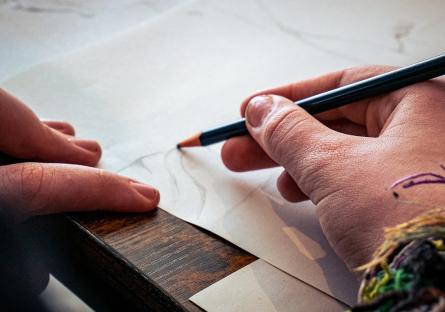
Doodling isn’t just a fun way to zone out and kill time; it can be good for your brain! When it comes to drawing, whether you’re etching astounding masterpieces or scribbling old band logos on the back of a notebook, the act of getting your art on can stimulate areas of your brain that can elevate your mood, ease anxieties, and give you an energizing boost of positive feelings. For this week’s Wellness Wednesday, we’re looking at how picking up a pencil can pick up your mental health.
It Reduces Stress
Putting some time aside to doodle and sketch can do wonders for your mood. Studies have found that drawing for longer than 45 minutes can lead to significantly lower levels of cortisol in the body. Cortisol is a hormone made in the adrenal gland that gets released in stressful situations. If you’re feeling tense, sitting down with a pencil and paper for a while can be an effective and simple way to get rid of the blues.
It Stimulates Dopamine Production
Making art can feel good because it activates reward pathways in the brain. This region of the brain is called the Mesolimbic pathway and acts as a conduit for regulating dopamine throughout the body. Dopamine is “the happy hormone;” it’s a neurochemical our body releases when we feel a sense of completion. It acts as a reward for positive stimuli and encourages us to learn and master other functions to keep those dopamine hits coming. The combination of intense focus, motor skills, and information processing that drawing requires works to stimulate our brain and give us opportunities to feel accomplished, thus releasing more pleasure-inducing dopamine throughout our system.
It Improves Memory Retention & Executive Function
Studies have found that drawing and performing other kinds of visual arts (including painting) can stimulate memory centers in the brain. Drawing can help improve memory retention over time. It’s also been found to impact the medial prefrontal cortex, the region of the brain associated with executive function. Executive function refers to mental processes (working memory, inhibition control, and cognitive flexibility) that help us problem solve and achieve goals. The research by Dr. Kaimal also found that drawing can also help improve our ability to problem solve due to its positive impact on executive function.
It Can Induce Flow States
Drawing requires a certain amount of focus to get results. That sustained concentration can sometimes put you into a flow state. This state of mind activates several networks in our brain focused on concentration, pleasure, relaxation, and cognition. During a flow state we experience increased theta wave activity in the frontal areas of the brain, which gives us a powerful feeling of immersion in whatever we’re doing. Time flies, you feel totally engaged in the task at hand, everything you say or do feels purposeful and productive in the moment. These moments of flow can be exhilarating and life-affirming, exactly the sort of experiences to seek out when you feel stuck in a rut or you’re unsure how to move forward.
Article by Austin Brietta
Want more wellness tips? Check out these stories: